#pyotr bagration
Text
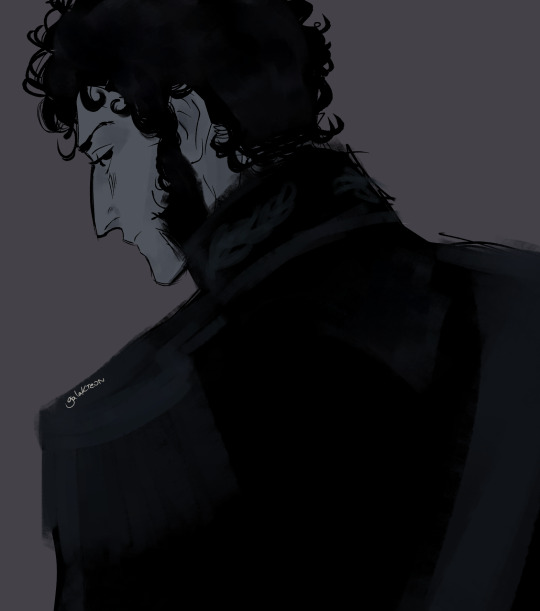

drawing this angle was painful but wtv leaving it like this aside the mistakes
148 notes
·
View notes
Text




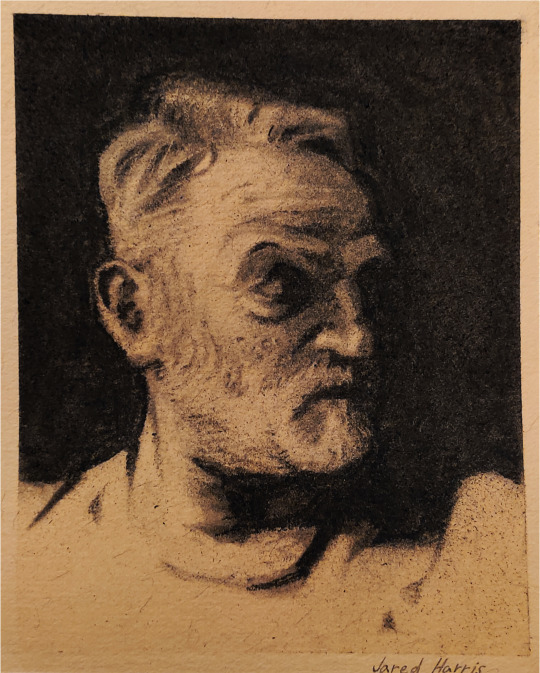
"Russia has no good generals. The only exception is Bagration."
Pyotr Bagration (just imagine theres also chair and table)
Dmitry Shostakovich
This ones so stupid im sorry
JFKs "Ich bin ein Berliner" speech but in animal crossing? (i know the implication with the donut is not historically accurate but still... this ones even more stupid)
Charcoal Jared Harris as Hari Seldon i picked bc i wanted to practise beard, but kinda messed up his nose lol
#pyotr bagration#napoleonic wars#myart#fanart#dmitri shostakovich#shostakovich#french revolution#frev art#frev memes#frev shitposting#maximilien robespierre#frev#joseph fouché#bonbon robespierre#augustin robespierre#charlotte robespierre#jfk#john f kennedy#jared harris#hari seldon#foundation apple tv
186 notes
·
View notes
Text

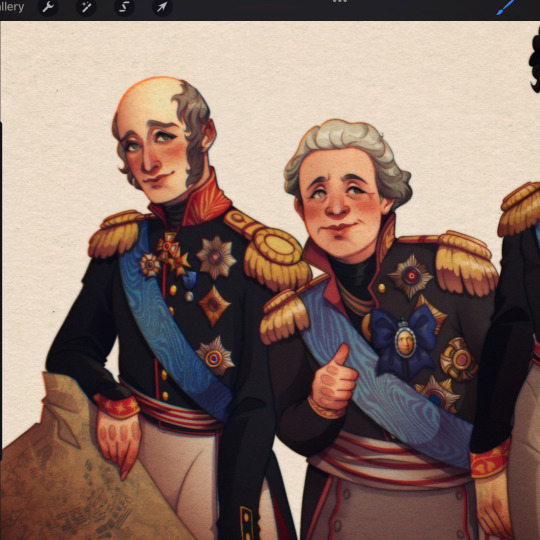
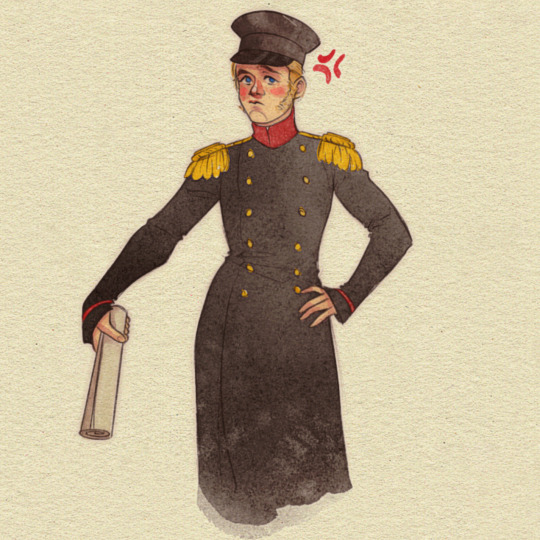
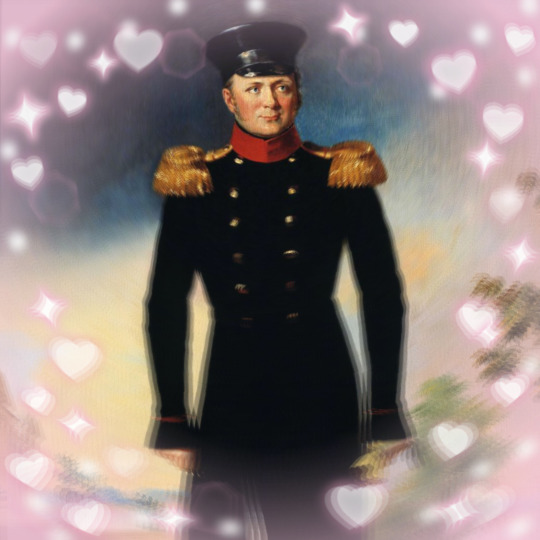
Whaaaaaaaaa??? Who are these guysss?? and what’s up with the tight pants?😨
This was so much fun to draw! 💗Though, their medals and ornaments made it kinda tedious. They’re just soo many, they look like Christmas trees! 🥲🎄I only now realised, as I’m writing this, that I forgot to draw feathers for Sasha’s hat omgggg nooo 😣
I hope everyone’s doing well! 🥰😘👏💖
#pyotr bagration#alexander i of russia#mikhail miloradovich#barclay de tolly#mikhail kutuzov#napoleonic era#digital art#I love old men 😘
134 notes
·
View notes
Text
CANT YOU SEE IM BUSSSYYY🗣️🗣️⁉️⁉️🗣️⁉️


My fav frames
#history#napoleonic wars#art#tsar alexander i#historical yaoi#alexander i of russia#gay men#extremely gay activity’s#arakcheev#i’m going insane#pyotr bagration#king magnum
76 notes
·
View notes
Text
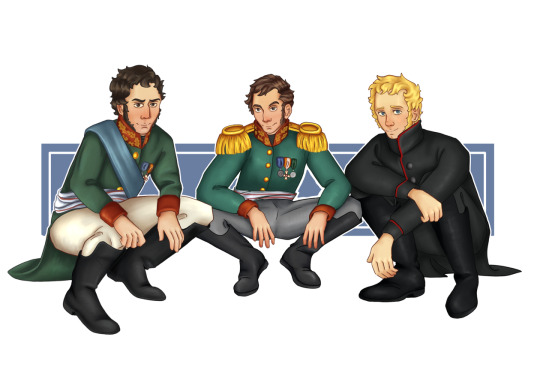
#pyotr bagration#mikhail miloradovich#tsar alexander i of russia#alexander i#napoleonic era#napoleonic wars#artists on tumblr
92 notes
·
View notes
Text
Форма Головы Барклаи(??)
(aka. The shape of Barclay's head(??))
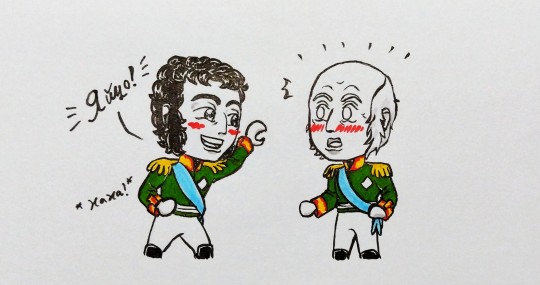
"Egg!" Haha!

"hehehehehe hehehehe!"
.
...and the sorrowful aftermath 🥲↓

"My head is not an egg..." 😭😭😭
.
.
(ko-fi)
#drawing#original art#manga#pen and ink#traditional art#brush pen#drawing pen#fan art#comic strip#napoleonic#napoleonic era#napoleonic wars#it's crack o'clock folks#sort of#pyotr bagration#pyotr ivanovich bagration#petre bagrationi#michael andreas barclay de tolly#tsar alexander i#alexander I#(come to think of it this is the first time I draw sasha 👀👀)#петр иванович багратион#Михаил Богданович Барклай де Толли#Александр I Павлович
45 notes
·
View notes
Text

I managed to finish this while I was away
#artists on tumblr#napoleonic#napoleonic era#digital art#illustration#pyotr bagration#Pyotr Ivanovich Bagration
55 notes
·
View notes
Text
Bagration: Man, this battle is not going well. Sure hope it doesn't get worse!
The cannonball approaching him at 250 miles per hour:

24 notes
·
View notes
Text

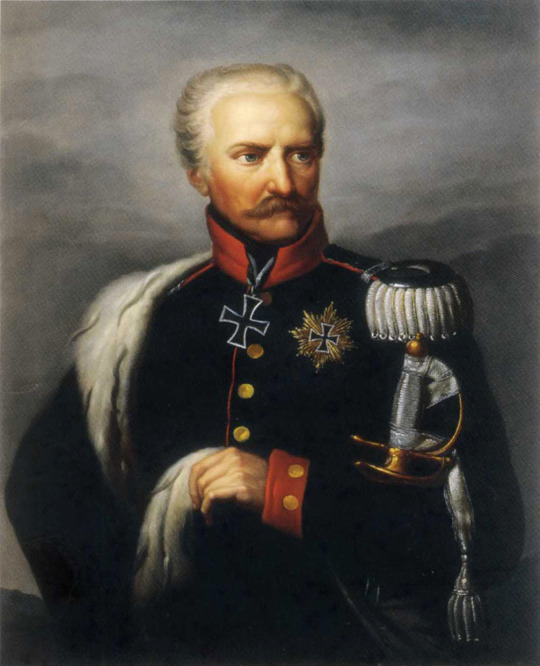
Pyotr Bagration
a. “From what I’ve read, he was a shy sweetheart outside of war, and an absolutely badass during battle. Like- it was partially that shyness that got him caught up in his less than favorable marriage. Also, have you seen his portrait by George Dawes?! It makes me swoon at the sight of it.”
b. “The best, the sexiest and certainly the greatest NOSE in the Russian army and perhaps all armies of that period. Noseys of Napoleonic era, beware! Believed to be a target of Grand Duchess Catherine Pavlovna's affections, a soldier's soldier celebrated for his courage and spirit, respected even by Napoleon and widely beloved… with the noted exceptions of his own wife and one Barclay de Tolly.”
c. “His sideburns and his nose”
Gebhard von Blücher
"DILF energy”
73 notes
·
View notes
Text
Priority Research 7 Predictions - Northern Parliament
Hoo boy, let's get this one over with. This one is going to be a long, long post.
As established in the Dragon Empery post, I will attempt to predict their possible skills as well based on their World of Warships gimmicks.
The thing is, the Soviet navy has a lot of made-up warships in World of Warships.
Let's begin with cruisers, since they're gonna take the longest to get through. There is a chance some of these ships end up being gacha units in the future, though; although with different names.
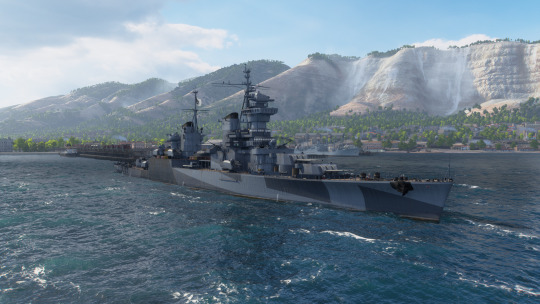
Pyotr Bagration
Pyotr Bagration is a Tier 8... cruiser. With 180mm guns, she classifies as a light cruiser; however, her 180mm guns have insane ballistics that make them hit harder than a lot of other heavy cruisers, even Tallinn.
Bagration is based off of Project 65, specifically one of the largest draft for Project 65, which is equipped with 3 triple 180mm gun turrets and a 15k ton displacement.
Unlike basically every Soviet cruiser from Tier 8 and above, she does not have access to radar. Her speed is high, but her general maneuverability isn't that good. I genuinely can't figure out a skill for her, but she's an option for a PR.
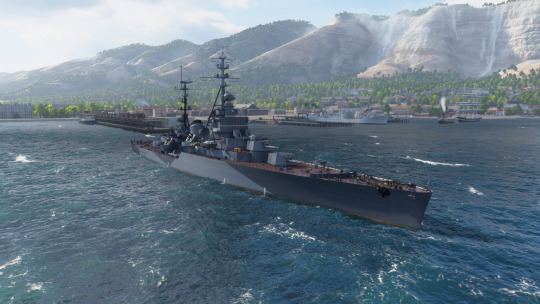
Ochakov
I like comparing Ochakov to Mainz in terms of performance. Ochakov is a light cruiser equipped with fast-firing 152mm guns in dual turrets. Compared to Mainz, she has worse armor, worse alpha damage, and worse DPM; but has an overall better AA and access to radar. Also, in WoWs, I think Ochakov is prettier. Not applicable in Azur Lane of course.
Her skills could involve something related to her fire rate, allowing her to fire faster; or a skill that allows her to detect all enemies and make them more susceptible to damage. Or something.
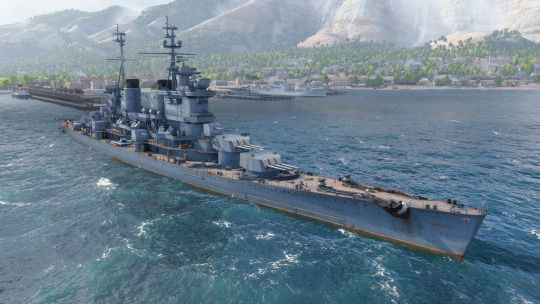
Dmitri Donskoi
Alright, I don't have much to say about Donskoi. She's literally a bigger Pyotr Bagration; she gets access to radar and a fourth triple 180mm turret with slightly worse reload (12.5s for Donskoi and 11s for Bagration). As a Tier 9 ship, she naturally has more health than her predecessors.
Both Donskoi and Bagration are equally as likely, and both are PR material.
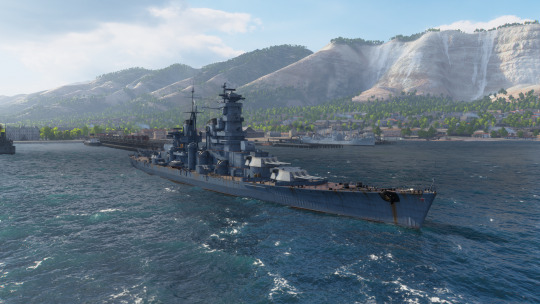
Riga
Not only does she have a cool name (Riga seems like a very pretty city), she's also an interesting ship. Her alpha damage ('alpha damage' being the damage she can dish out in one salvo) is brutal with nine 220mm guns, although her turret traverse time resembles more a battleship than a cruiser (32.7 seconds to turn 180º. Soyuz's gigantic 406mm turrets are faster at 30s for 180º).
Riga is not very stealthy, nor very maneuvrable. However, she is a bit of a grandmother to the Stalingrad, which we'll see below in a second.
Riga's gimmick in AL could make her do vastly improved damage with AP guns, or make her outright ignore stuff like medium armor. If that's too broken for AL or not is above me. Both Riga and Donskoi could be PRs, tho.
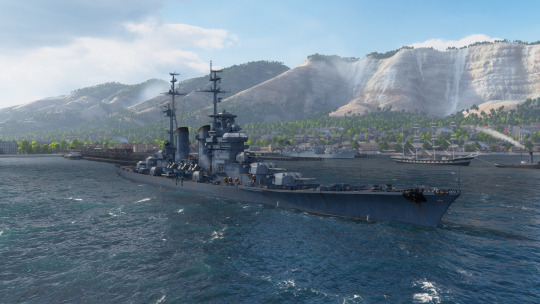
Alexander Nevsky
Now onto the three possible DR cruisers.
Nevsky is a unique HE spammer. HE spamming is, as the name implies, spamming High Explosive; a tactic many kinds of ship can perform very effectively (Harbin, for example, is a dedicated HE spammer in WoWs). However, Nevsky trades damage per minute for alpha damage.
Her reload of 6 seconds is not bad at all, however, much better ships exist for the task - Jinan's reload is 3.5 seconds, and she has 4 more guns. However, Jinan has weak, pathetic, American 127mm guns; while Nevsky has glorious, patriotic Soviet 180mm guns. These eight 180mm guns are considerably better than those found on Tallinn, Bagration or Donskoi.
To top it all off, she has access to the usual convo of radar + hydroacoustic search, meaning she can find you no matter what.
Her skills could involve a much improved damage output or fire chance for HE guns, and a skill that allows her to instantly detect submarines the moment they appear, or similar. DR material.
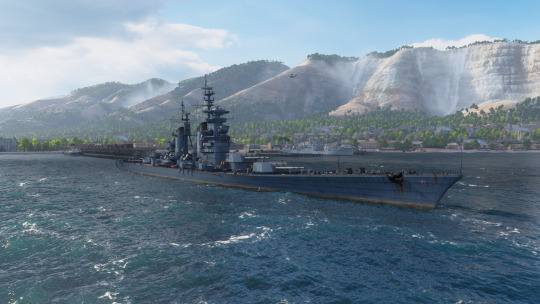
Petropavlovsk
There was some controversy the moment Petropavlovsk was introduced as a replacement for the previous Tier 10 heavy cruiser (Moskva), as both ships share the same gun calliber of 220mm, but Petropavlovsk's shells do almost as much damage and have almost the same penetration values as Bismarck.
Bismarck is not the best Tier 8 battleship, of course. But Bismarck is a battleship, Petropavlovsk is a cruiser. And her reload of 14 seconds means this cruiser that has 1 more gun than Bismarck and almost the same values as Bismarck could have almost twice the damage per minute of poor old Bismarck (Bismarck's reload is 26 seconds).
That should tell you a lot already.
Petropavlovsk is a "heavy cruiser", the same way Ägir or Alaska are "heavy cruisers". Her guns are insane, and the ship has a very good armor scheme as well. Since she sits so low above the water, it's harder to hit her from a distance - your shells will hit the waves before they touch her hull, losing momentum. She's fast too, although her concealment is... well, she can be seen from 16.3km away (base values). Kremlin (remember that name) can be seen from 16.5km, and she's considerably bigger than Petropavlovsk.

Stalingrad
Known as 'Battlecruiser Stalingrad' by the WoWs community, Stalingrad is a Tier 10 Soviet heavy cruiser armed with nine 305mm guns.
They're legitimately one of the best 305mm guns in the whole game. Mecklenburg, a German Tier 10 battleship with sixteen 305mm guns, deals considerably less damage per gun than Stalingrad.
Typical of Soviet heavy cruisers, Stalingrad's high explosive is pathetic while her armor piercing is beyond excellent. Stalin himself guides each projectile with an unnatural accuracy, his hand reaching from beyond the grave to ensure Stalingrad's shells land on the target.
Stalingrad could be a large cruiser meant to spam AP, dealing raw damage to anyone that crosses her path. All her skills could be self-buffs, as the ship is very egocentric in WoWs.
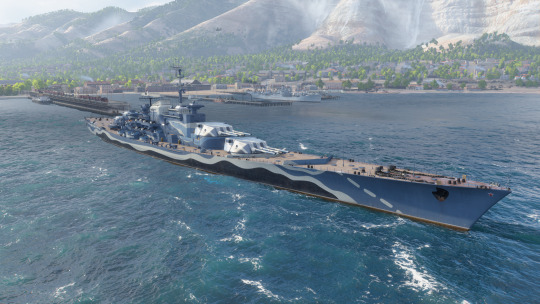
Borodino
Now onto the battleships. There's only 3 so this should be quick.
Borodino is a weird design. Vodka was involved.
She takes the Richelieu approach of only having front-facing turrets. Borodino is equipped with two triple 406mm gun turrets, the same one found on the Sovetsky-Soyuz class. They are above average in terms of accuracy, earning her the nickname of "tier 8 Stalingrad". In my own personal experience, they're very (literally) hit or miss.
Borodino has a radar, though. That's unique among battleships, with only 2 other ones having radar to the best of my knowledge (Missouri and Constellation).
Borodino is a tank. She is best played around islands, bow-in. Her small superstructure and large, well protected bow, as well as front-facing turrets; means Borodino is perfect for bow tanking at Tier 8.
She's PR material for sure, but she could be an interesting PR.
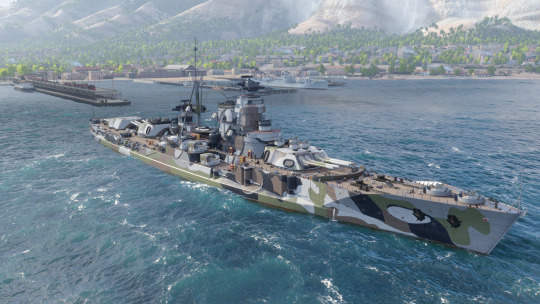
Navarin
I'm torn about Navarin.
On the one hand, Navarin could easily be DR material. She's unique among all Soviet warships in WoWs, no other ship in the entire nation sharing her gimmick even remotely. There are two Italian battleships and two Italian cruisers that excell at secondary gun warfare; France has at least 2 ships, the US Navy has West Virginia '44, Massachussetts, Georgia and Ohio. Japan has Iwami, Shikishima and Kii. But the Soviet Union? Their only ship that's good at secondary guns is Navarin.
Besides, look at her design. She's old! Her design began in 1914; the Soviet Union wasn't even a thing back then. This monstrosity has three quadruple 406mm guns with rifles that aren't bad at all, as well as a wall of 130mm secondary guns on each side. She even has casemate guns, at Tier 9! She fights against modern warships such as Iowa, Swedish post-war destroyers, and aircraft carriers with jet planes. Granny needs DR status.
But yes, her gimmick in WoWs is that - just like Friedrich der Grosse, Prinz Rupprecht or Odin; she's a secondary gun brawler. She's meant to get close to the enemy and blast her 17 130mm guns per side, and 12 406mm guns, at 10km or less. And yes, this girl is covered in guns.

Kremlin
I don't lose anything by mentioning her.
With the introduction of gacha UR Sovetsky Soyuz, DR Kremlin is unlikely. Well, so was Hindenburg.
Kremlin is the epitome of Soviet battleships. Extremely tanky when bow-in, vulnerable when broadside, big guns that do big damage but have unreliable accuracy. I love her. Kremlin is a big, slow, slumbering warship that still somehow manages to have a 29 second reload on her monstrous 457mm guns.
Her skills would represent this sheer damage potential, maybe allowing a skill that redirects the damage the vanguard takes into a shield she generates - like a much, much better Illustrious.

Admiral Nakhimov
Finally, we have another aircraft carrier.
Nakhimov is different enough from Chkalov, as well as being a Tier 10 while Chkalov is Tier 8.
Nakhimov shares the same gameplay as the other Soviet CVs - big number of planes in a single squadron. Her torpedo bombers consist of a flight of 7 planes, each one dropping a torpedo, all at the same time. She fires a total of 32 rockets from her 8 attack aircraft, all at the same time. She drops 7 powerful bombs with her skip bombers.
That's right, Nakhimov doesn't have dive bombers. She is equipped with skip bombers, which are bombers that drop their payload in such a way that it bounces on the water like a rock until it hits the enemy. Yes, those things existed in real life.
Nakhimov could be an extremely versatile and hyper-aggressive DR CV, capable of taking on all sorts of enemies.
11 notes
·
View notes
Text

watched kutuzov (1943) too many times, had to doodle them in their lovely long coats
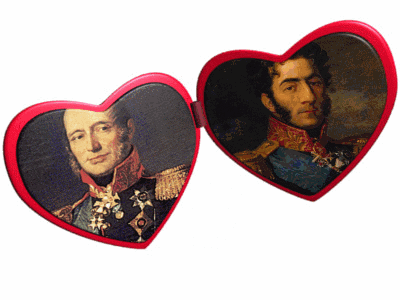
#napoleonic wars#russian empire#napoleonic#barclay de tolly#barclay#pyotr bagration#bagration#history#history art#art#багратион#Пётр багратион#барклай де толли#барклай
160 notes
·
View notes
Note
WHAT? I won't even get to see Napoleon BonaJordan do his legendary, completely historically accurate (My gran told me) DUNK AT WATERLOO? This day keeps getting worse.
Alas, would this be a bad time to mention the huge battle sequence they had planned for the Battle of Schöngrabern?
Odd creative direction to genderswap Pyotr Bagration and have her lesbian lover die on the battlefield, prompting her to fight Napoleon BonaJordan one-on-one...
3 notes
·
View notes
Text
Kutuzov Prospect by The Internal Expression
youtube
Music by The Internal Expression &
Poems by Denis Davydov &
Paintings by Peter Von Hess &
some episodes from the film
War and Peace by Sergey Bondarchuk
were used in this video.
The track Kutuzov Prospect is dedicated
to the victory of the Russian Army led
by Mikhail Kutuzov in the Russian campaign of 1812
I don't want highest awards
And dreams of conquest
Don't disturb my peace!
But if a fierce foe dares
to oppose us,
My first duty, my sacred duty -
Rise up for our homeland again.
Denis V. Davydov, Elegy IV
The French invasion of Russia, also known as the Russian campaign (French: Campagne de Russie) and in Russia as the Patriotic War of 1812 (Russian: Оте́чественная война́ 1812 го́да), was initiated by Napoleon with the aim of compelling the Russian Empire to comply with the continental blockade of the United Kingdom. Widely studied, Napoleon’s incursion into Russia stands as a focal point in military history, recognized among the most devastating military endeavors globally. In a span of fewer than six months, the campaign exacted a staggering toll, claiming the lives of nearly a million soldiers and civilians.
On 24 June 1812 and subsequent days, the initial wave of the multinational Grande Armée crossed the Niemen River, marking the entry from the Duchy of Warsaw into Russia. Employing extensive forced marches, Napoleon rapidly advanced his army of nearly half a million individuals through Western Russia, encompassing present-day Belarus, in a bid to dismantle the disparate Russian forces led by Barclay de Tolly and Pyotr Bagration totaling approximately 180,000–220,000 soldiers at that juncture. Despite losing half of his men within six weeks due to extreme weather conditions, diseases and scarcity of provisions, Napoleon emerged victorious in the Battle of Smolensk. However, the Russian Army, now commanded by Mikhail Kutuzov, opted for a strategic retreat, employing attrition warfare against Napoleon compelling the invaders to rely on an inadequate supply system, incapable of sustaining their vast army in the field.
The fierce Battle of Borodino, located 110 kilometres (70 mi) west of Moscow, concluded as a narrow victory for the French although Napoleon was not able to beat the Russian army and Kutuzov could not stop the French. At the Council at Fili Kutuzov made the critical decision not to defend the city but to orchestrate a general withdrawal, prioritizing the preservation of the Russian army. On 14 September, Napoleon and his roughly 100,000-strong army took control of Moscow, only to discover it deserted, and set ablaze by its military governor Fyodor Rostopchin. Remaining in Moscow for five weeks, Napoleon awaited a peace proposal that never materialized. Due to favorable weather conditions, Napoleon delayed his departure, hoping to secure supplies through an alternate route. However, after losing the Battle of Maloyaroslavets he was compelled to retrace his initial path.
As early November arrived, snowfall and frost complicated the retreat. Shortages of food and winter attire for the soldiers and provision for the horses, combined with relentless guerilla warfare from Russian peasants and Cossacks resulted in significant losses. Once again more than half of the soldiers perished on the roadside succumbing to exhaustion, typhus and the unforgiving continental climate. The once-formidable Grande Armée disintegrated into a disordered multitude, leaving the Russians with no alternative but to witness the crumbling state of the invaders.
During the Battle of Krasnoi, Napoleon faced a critical scarcity of cavalry and artillery due to severe snowfall and icy conditions. Employing a strategic maneuver, he deployed the Old Guard against Miloradovich, who obstructed the primary road to Krasny, effectively isolating him from the main army. Davout successfully broke through, Eugene de Beauharnais and Michel Ney were forced to take a detour. Despite the consolidation of several retreating French corps with the main army, by the time they reached the Berezina, Napoleon commanded only around 49,000 troops alongside 40,000 stragglers of little military significance. On 5 December, Napoleon departed from the army at Smorgonie in a sled and returned to Paris. Within a few days, an additional 20,000 people succombed to the bitter cold and diseases carried by lice. Murat and Ney assumed command, pressing forward but leaving over 20,000 men in the hospitals of Vilnius. The remnants of the principal armies, disheartened, crossed the frozen Niemen and the Bug.
Napoleon’s initial force upon entering Russia exceeded 450,000 men, accompanied by over 150,000 horses, approximately 25,000 wagons and nearly 1,400 artillery pieces. However, the surviving count dwindled to a mere 120,000 men (excluding early deserters); signifying a staggering loss of approximately 380,000 lives throughout the campaign, half of which resulted from diseases. This catastrophic outcome shattered Napoleon’s once-untarnished reputation of invincibility. Sources. French invasion of Russia, from Wikipedia, the free encyclopedia
В создании видео Кутузовский проспект использовались:
Музыка The Internal Expression
Стихи Дениса Давыдова
Картины Петера Фон Гесса
Эпизоды фильма Война и Мир Сергея Бондарчука
Трек Кутузовский проспект посвящён победе Русской армии во главе с Михаилом Кутузовым в Отечественной войне 1812 года
Не хочу высоких званий,
И мечты завоеваний
Не тревожат мой покой!
Но коль враг ожесточенный
Нам дерзнёт противустать,
Первый долг мой, долг священный -
Вновь за родину восстать.
Денис Давыдов, Элегия IV
Оте́чественная война́ 1812 го́да, во французской историографии - Ру́сская кампа́ния 1812 го́да (фр. Campagne de Russie 1812) - военный конфликт между Российской и Первой Французской империей, протекавший на территории России в период с 12 (24) июня до 14 (26) декабря 1812 года. В дореволюционной российской историографии традиционно именовался «нашествием двенадцати языков» (уст. Нашествіе двунадесяти языковъ) в связи с многонациональным составом армии Наполеона.
Причинами войны стали отказ Российской империи активно поддерживать континентальную блокаду, в которой Наполеон видел главное оружие против Великобритании, а также политика Наполеона в отношении европейских государств, проводившаяся без учёта интересов России.
«Масштаб операций в 1812 г. почти невероятен, а потери - военные и гражданские, французских захватчиков и русских защитников - вызывают содрогание даже сегодня, несмотря на несоизмеримо большие потери в двух последовавших одна за другой мировых войнах в XX в.».
На первом этапе войны (с июня по сентябрь 1812 года) русская армия с боями отступала от границ России до Москвы, дав под Москвой Бородинское сражение.
В начале второго этапа войны (с октября по декабрь 1812 года) наполеоновская армия маневрировала, стремясь уйти на зимние квартиры в неразорённые войной местности, а затем отступала до границ России, преследуемая русской армией, голодом и морозами.
Война закончилась почти полным уничтожением наполеоновской армии, освобождением территории России и переносом военных действий на земли Варшавского герцогства и Германии в 1813 году (см. Война Шестой коалиции). Среди причин поражения армии Наполеона российский историк Н. А. Троицкий называет всенародное участие в войне и героизм русской армии, неготовность французской армии к боевым действиям на больших пространствах и в природно-климатических условиях России, полководческие дарования русского главнокомандующего М. И. Кутузова и других генералов русской армии.
В 1789-1799 годах во Франции произошла Великая французская революция, закончившаяся приходом к власти Наполеона Бонапарта. Реакцией нескольких крупных монархических европейских стран (включая Россию и Великобританию) было создание серии антифранцузских коалиций, изначально ставивших целью восстановление монархии Бурбонов, но позже принявших оборонительный характер в попытке остановить дальнейшее распространение французской экспансии в Европе. Война четвёртой коалиции закончилась для России поражением русских войск в битве под Фридландом 14 июня 1807 года. Император Александр I заключил с Наполеоном Тильзитский мир, по которому обязался присоединиться к континентальной блокаде Великобритании, что противоречило экономическим и политическим интересам России. По мнению русского дворянства и армии, условия мирного договора были унизительны и позорны для страны. Русское правительство использовало Тильзитский договор и последовавшие за ним годы для накопления сил к предстоящей борьбе с Наполеоном.
По итогам Тильзитского мира и Эрфуртского конгресса Россия в 1808 году отобрала у Швеции Финляндию и сделала ряд других территориальных приобретений; Наполеону же развязала руки для покорения всей Европы. Французские войска после ряда аннексий, произведённых главным образом за счёт австрийских владений (см. Война пятой коалиции), придвинулись вплотную к границам Российской империи.
После 1807 года главным и, по сути, единственным врагом Наполеона оставалась Великобритания. Великобритания захватила колонии Франции в Америке и Индии и препятствовала французской торговле. Учитывая, что Англия господствовала на море, единственным реальным оружием Наполеона в борьбе с ней была континентальная блокада, эффективность которой зависела от желания других европейских государств соблюдать санкции. Наполеон настойчиво требовал от Александра I более последовательно осуществлять континентальную блокаду, но наталкивался на нежелание России разрывать отношения со своим главным торговым партнёром.
В 1810 году русское правительство ввело свободную торговлю с нейтральными странами, что позволяло России торговать с Великобританией через посредников, и приняло заградительный тариф, который повышал таможенные ставки, главным образом на ввозившиеся французские товары. Это вызвало негодование французского правительства.
Наполеон не был наследственным монархом и поэтому желал подтвердить легитимность своего коронования через брак с представительницей одного из великих монархических домов Европы. В 1808 году российскому царствующему дому было сделано предложение о браке между Наполеоном и сестрой Александра I великой княжной Екатериной. Предложение было отклонено под предлогом помолвки Екатерины с принцем Саксен-Кобургским. В 1810 году Наполеону было отказано вторично, на этот раз относительно брака с другой великой княжной — 14-летней Анной (впоследствии королевой Нидерландов). В том же году Наполеон женился на принцессе Марии-Луизе Австрийской, дочери императора Австрии Франца II. По мнению историка Е. В. Тарле, «австрийский брак» для Наполеона «был крупнейшим обеспечением тыла, в случае, если придётся снова воевать с Россией». Двойной отказ Наполеону со стороны Александра I и брак Наполеона с австрийской принцессой вызвали кризис доверия в русско-французских отношениях и резко их ухудшили.
В начале 1811 года Россия, опасавшаяся восстановления Польши, стянула несколько дивизий к границам Варшавского герцогства, что было воспринято Наполеоном как военная угроза герцогству.
В 1811 году Наполеон заявил своему послу в Варшаве аббату де Прадту: «Через пять лет я буду владыкой всего мира. Остаётся одна Россия, - я раздавлю её…».
Согласно традиционным представлениям в российской науке, от последствий континентальной блокады, к которой Россия присоединилась по условиям Тильзитского мира 1807 года, страдали русские землевладельцы и купцы и, как следствие, государственные финансы России. Однако ряд исследователей утверждает, что благосостояние основных податных сословий, в числе которых были купечество и крестьянство, не претерпело существенных изменений в период блокады. Об этом, в частности, можно судить по динамике недоимок по платежам в бюджет, которая показывает, что эти сословия даже нашли возможность выплачивать в рассматриваемый период повышенные налоги. Эти же авторы утверждают, что ограничение ввоза иностранных товаров стимулировало развитие российской промышленности. Снижение таможенных сборов, наблюдавшееся в период блокады, не имело большого влияния на российский бюджет, поскольку пошлины не являлись его существенной статьёй, и даже в момент достижения своей максимальной величины в 1803 году, когда они составили 13,1 млн руб., на их долю приходилось всего 12,9 % доходов бюджета. Поэтому, согласно этой точке зрения, континентальная блокада Англии была для Александра I только поводом к разрыву отношений с Францией.
В 1807 году из польских земель, входивших, согласно второму и третьему разделам Польши, в состав Пруссии и Австрии, Наполеон создал Великое герцогство Варшавское. Наполеон поддерживал мечты Варшавского герцогства воссоздать независимую Польшу до границ бывшей Речи Посполитой, что было возможно сделать только после отторжения от России части её территории. В 1810 году Наполеон отобрал владения у герцога Ольденбургского, родственника Александра I, что вызвало негодование в Петербурге. Александр I требовал передать Варшавское герцогство как компенсацию за отнятые владения герцогу Ольденбургскому или ликвидировать его как самостоятельное образование.
Вопреки условиям Тильзитского соглашения, Наполеон продолжал оккупировать своими войсками территорию Пруссии, Александр I требовал вывести их оттуда.
С конца 1810 года в европейских дипломатических кругах стали обсуждать грядущую войну между Французской и Российской империями. На дипломатическом приёме 15 августа 1811 года Наполеон гневно высказал в адрес России ряд угроз русскому послу в Париже князю Куракину, после чего в Европе уже никто не сомневался в близкой войне Франции и России. К осени 1811 года российский посол в Париже князь Куракин докладывал в Санкт-Петербург о признаках неизбежной войны.
Источник. Отечественная война 1812 года из Википедии - свободной энциклопедии.
#rock#rockmusic#music#musician#Рокмузыка#Музыка#Музыканты#war and peace#warandpeace#peter von hess#petervonhess#Отечественная война 1812#Patriotic War of 1812#French invasion of Russia#War of 1812#Warof1812#Kutuzov#Mikhail Kutuzov#MikhailKutuzov#Denis Davydov#Hermitage Museum#HermitageMuseum#RussianEmpire#NapoleonBonaparte#famousartists#theintexp#Youtube
0 notes
Text


I have been infected with a Bagration obsession
Anyways first time atempting a actual drawing with my finger on my phone

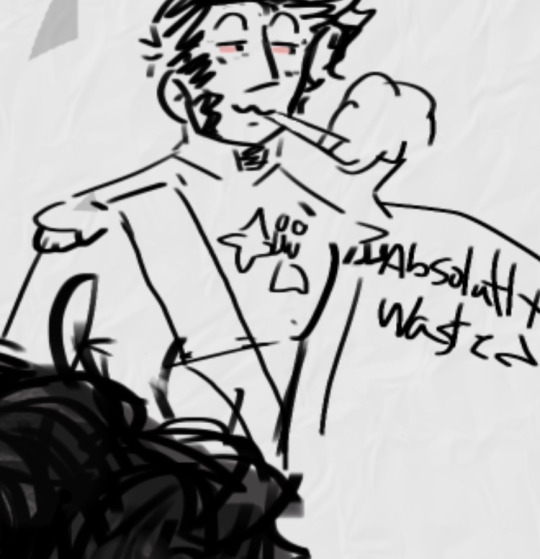

Free me!!!
#history#napoleonic wars#tsar alexander i#art#historical yaoi#doodles#gay men#pyotr bagration#imperial russia#shitposting#barclay de tolly#extremely gay activity’s
65 notes
·
View notes
Text

#napoleonic era#napoleonic wars#alexander suvorov#matvei platov#alexander i of russia#alexander i#pyotr bagration#mikhail miloradovich#michael barclay de tolly#mikhail kutuzov#fanart#my art
50 notes
·
View notes
Text

"Ooooooh Noooooooo it's that *season* again, I have to host receptions and balls again, I have to borrow money agaaaiiin aidmdlejfkfufrjgnglgkgkghkkjnj" 😩😩😭💀
#friedland ended but at what cost 💀#drawing#original art#manga#doodle#doodles#pen and ink#brush pen#traditional art#fan art#pyotr ivanovich bagration#pyotr bagration#petre bagrationi#петр иванович багратион#napoleonic#napoleonic era#petya absolutely Does NOT look forward to hosting balls 😩💀
23 notes
·
View notes